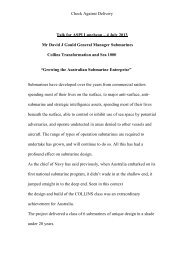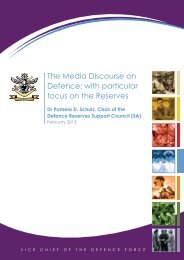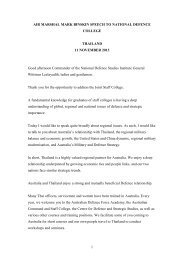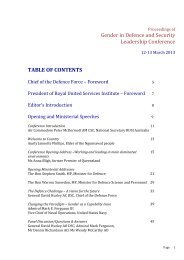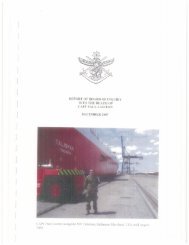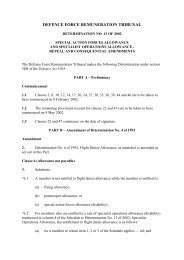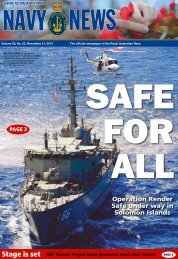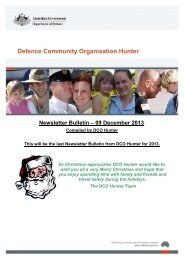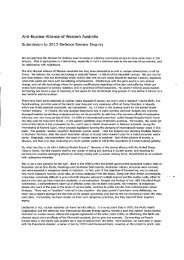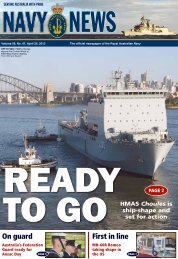Victory in the Pacific Mess Dinner at HMAS Watson
Victory in the Pacific Mess Dinner at HMAS Watson
Victory in the Pacific Mess Dinner at HMAS Watson
Create successful ePaper yourself
Turn your PDF publications into a flip-book with our unique Google optimized e-Paper software.
Navy 2013 Anzac Day Address ‐ Tasmania<br />
DTG 25 Apr 2013<br />
Length<br />
871 words – about 8 m<strong>in</strong>utes<br />
O<strong>the</strong>r<br />
speakers<br />
Audience<br />
Themes<br />
General public <strong>at</strong> Anzac Day services/events<br />
Endur<strong>in</strong>g legacy of ANZAC Gallipoli experience<br />
Navy’s l<strong>in</strong>ks with Tasmanians – ma<strong>in</strong>ly Nor<strong>the</strong>rn<br />
Tasmanians<br />
This is a draft generic ANZAC Day address – it is based on <strong>the</strong> 2011/12<br />
address given by CDRE Spedd<strong>in</strong>g and orig<strong>in</strong>ally drafted by SPC‐A.<br />
Ra<strong>the</strong>r than <strong>the</strong> references to <strong>HMAS</strong> Perth, Prisoners of War and<br />
<strong>HMAS</strong> Yarra, it acknowledges <strong>the</strong> service of Navy people with a l<strong>in</strong>k to<br />
Tasmania.
In a n<strong>at</strong>ion’s history, gre<strong>at</strong> events – whe<strong>the</strong>r <strong>in</strong> peace or war – live on<br />
<strong>in</strong> our memories. We remember <strong>the</strong>m, not necessarily for wh<strong>at</strong> <strong>the</strong>y<br />
achieved, nor for whe<strong>the</strong>r <strong>the</strong>y were victories or defe<strong>at</strong>s. Ra<strong>the</strong>r, we<br />
remember <strong>the</strong>m for <strong>the</strong> quality of <strong>the</strong> human endeavour; for <strong>the</strong><br />
extraord<strong>in</strong>ary deeds by ord<strong>in</strong>ary men and women, for <strong>the</strong> examples<br />
and <strong>the</strong> legends th<strong>at</strong> <strong>in</strong>spire us today.<br />
So it is with ANZAC day.<br />
In <strong>the</strong> dawn of April <strong>the</strong> 25 th 1915, <strong>the</strong> first wave of 1500 troops from<br />
<strong>the</strong> Australian 3 rd<br />
Brigade landed <strong>at</strong> <strong>the</strong> beach we now know as<br />
ANZAC Cove – <strong>the</strong> first of almost 60,000 Australian and New Zealand<br />
troops to particip<strong>at</strong>e <strong>in</strong> <strong>the</strong> Gallipoli campaign. Transported across<br />
oceans and delivered <strong>in</strong> darkness to a land <strong>the</strong>y barely knew, <strong>the</strong>se<br />
young, untested men advanced steadily onwards and upwards;<br />
towards wi<strong>the</strong>r<strong>in</strong>g gunfire, across impossible terra<strong>in</strong> and a<br />
determ<strong>in</strong>ed enemy.<br />
On this day and <strong>in</strong> <strong>the</strong> months to come, <strong>the</strong> ANZACs demonstr<strong>at</strong>ed<br />
<strong>the</strong> best of Australia – <strong>the</strong>y faced this terrify<strong>in</strong>g ordeal with courage,<br />
camaraderie and honour. They did not shirk <strong>the</strong>ir duty.
The bloody and bitterly fought campaign for possession of <strong>the</strong><br />
Gallipoli pen<strong>in</strong>sula lasted for eight long months. The troops endured<br />
constant danger, depriv<strong>at</strong>ion and <strong>the</strong> extremes of wea<strong>the</strong>r. Over a<br />
quarter of million soldiers from Turkish and Allied forces were killed<br />
or wounded. 8709 Australians were killed <strong>in</strong> action or died of wounds<br />
or disease <strong>at</strong> Gallipoli – about one <strong>in</strong> every six personnel. 2721 New<br />
Zealanders were killed <strong>in</strong> action or died of wounds or disease –<br />
almost one <strong>in</strong> every three New Zealanders who particip<strong>at</strong>ed <strong>in</strong> <strong>the</strong><br />
Gallipoli oper<strong>at</strong>ion.<br />
As terrible as <strong>the</strong>se casualty numbers were, <strong>the</strong>y were only a small<br />
portion of over 130,000 Turkish and Allied sailors and soldiers who<br />
died <strong>in</strong> <strong>the</strong> Gallipoli campaign, and <strong>the</strong> precursor to even gre<strong>at</strong>er<br />
casualties <strong>the</strong> ANZACs endured on <strong>the</strong> Western Front, where <strong>the</strong> bulk<br />
of Australia’s 61,522 war dead paid <strong>the</strong> ultim<strong>at</strong>e sacrifice.<br />
The courageous efforts of <strong>the</strong> ANZACs are echoed <strong>in</strong> <strong>the</strong> selfless<br />
efforts of gener<strong>at</strong>ions of defence personnel. We remember and<br />
honour those who served, and those who died; <strong>in</strong> <strong>the</strong> air, <strong>in</strong> <strong>the</strong><br />
muddy trenches, and <strong>in</strong> <strong>the</strong> lonely seas and oceans. The challenges of<br />
air oper<strong>at</strong>ions <strong>in</strong> New Gu<strong>in</strong>ea might differ to those of comb<strong>in</strong>ed arms<br />
oper<strong>at</strong>ions <strong>in</strong> <strong>the</strong> fields of Vietnam or <strong>the</strong> convoy escort <strong>in</strong> seas and
oceans around <strong>the</strong> world. But <strong>the</strong> characteristics of <strong>the</strong> people –<br />
courage, m<strong>at</strong>eship, service and sacrifice – <strong>the</strong>se characteristics do not<br />
change. Th<strong>at</strong> is why, nearly a century after <strong>the</strong> events <strong>at</strong> Gallipoli,<br />
<strong>the</strong>y can cont<strong>in</strong>ue to <strong>in</strong>spire us.<br />
It is also important to remember and honour <strong>the</strong> families and friends<br />
of those who served. They supported and loved <strong>the</strong>m and, for many,<br />
<strong>the</strong>ir loss is endur<strong>in</strong>g.<br />
It is right th<strong>at</strong> on ANZAC Day we take pride <strong>in</strong> <strong>the</strong>ir efforts, reflect on<br />
<strong>the</strong>ir character and, most importantly, remember <strong>the</strong>ir sacrifice. They<br />
were ord<strong>in</strong>ary Australians, but <strong>the</strong>y did extraord<strong>in</strong>ary th<strong>in</strong>gs. Our<br />
n<strong>at</strong>ion was built on <strong>the</strong> found<strong>at</strong>ions laid by citizens such as <strong>the</strong>se.<br />
From a Navy perspective, it is a particular honour to be here <strong>in</strong><br />
Tasmania. Uniquely appropri<strong>at</strong>e for Anzac Day, <strong>the</strong>re have been<br />
three ships named Launceston, <strong>the</strong> first of which was transferred to<br />
<strong>the</strong> Turkish Navy after <strong>the</strong> Second World War. Half of our submar<strong>in</strong>e<br />
fleet is named after Tasmanians, honour<strong>in</strong>g <strong>the</strong>ir service and sacrifice<br />
to Australia. Vice Admiral Sir John Coll<strong>in</strong>s, Capta<strong>in</strong> of <strong>HMAS</strong> Sydney,<br />
from Delora<strong>in</strong>e; Able Seaman Teddy Sheean <strong>in</strong> <strong>HMAS</strong> Armidale who<br />
was from Barr<strong>in</strong>gton; and Capta<strong>in</strong> Emile “Dishy” Decha<strong>in</strong>eaux killed <strong>in</strong><br />
a kamikaze <strong>at</strong>tack on <strong>HMAS</strong> Australia <strong>in</strong> <strong>the</strong> B<strong>at</strong>tle of Leyte Gulf <strong>in</strong>
1944 from Launceston. There are o<strong>the</strong>rs who are not so well known,<br />
but whose actions are strong threads <strong>in</strong> <strong>the</strong> rich tapestry of ANZAC –<br />
such as Lead<strong>in</strong>g Cook Emms, also from Launceston, who died on <strong>the</strong><br />
deck of <strong>HMAS</strong> Kara Kara dur<strong>in</strong>g <strong>the</strong> bomb<strong>in</strong>g of Darw<strong>in</strong> <strong>in</strong> 1942,<br />
defend<strong>in</strong>g his ship, defend<strong>in</strong>g <strong>the</strong> city, defend<strong>in</strong>g our country. Or one<br />
of Australia's three most highly decor<strong>at</strong>ed naval officers <strong>in</strong> World War<br />
II, Kenneth Robert Hudspeth, DSC and two bars, who enlisted <strong>in</strong><br />
Hobart, and dist<strong>in</strong>guished himself serv<strong>in</strong>g <strong>in</strong> X‐craft midget<br />
submar<strong>in</strong>es, <strong>in</strong>volved <strong>in</strong> <strong>the</strong> <strong>at</strong>tack and s<strong>in</strong>k<strong>in</strong>g of <strong>the</strong> German<br />
b<strong>at</strong>tleship Tirpitz. So it is special to be here.<br />
Australia’s current Navy, Army and Air Force personnel always aim to<br />
live up to <strong>the</strong> standards of service set by <strong>the</strong> ANZACs. As we speak<br />
<strong>the</strong>re are about 3000 personnel deployed on oper<strong>at</strong>ions around <strong>the</strong><br />
world, from South Sudan and Egypt, to <strong>the</strong> Middle East, through to<br />
our region <strong>in</strong> South East Asia and <strong>the</strong> <strong>Pacific</strong>. They are conduct<strong>in</strong>g<br />
oper<strong>at</strong>ions aga<strong>in</strong>st pir<strong>at</strong>es, drug smugglers and <strong>in</strong>surgents,<br />
conduct<strong>in</strong>g fishery and maritime security p<strong>at</strong>rols, assist<strong>in</strong>g<br />
communities by render<strong>in</strong>g safe old ordnance and support<strong>in</strong>g border<br />
security oper<strong>at</strong>ions.
2013 is also a particularly significant year for <strong>the</strong> Australian Defence<br />
Force and <strong>the</strong> Navy, as we celebr<strong>at</strong>e <strong>the</strong> centenary of <strong>the</strong> arrival of<br />
Australia’s first Fleet Unit. It saw action almost immedi<strong>at</strong>ely <strong>at</strong> <strong>the</strong><br />
outbreak of <strong>the</strong> First World War, secur<strong>in</strong>g Australian and regional<br />
w<strong>at</strong>ers and escort<strong>in</strong>g our troops overseas. As a n<strong>at</strong>ional celebr<strong>at</strong>ion<br />
of <strong>the</strong> arrival of <strong>the</strong> Fleet Unit, <strong>in</strong> October this year <strong>the</strong>re will be <strong>the</strong><br />
Intern<strong>at</strong>ional Fleet Review <strong>in</strong> Sydney.<br />
The first ANZACs showed wh<strong>at</strong> Australians can do <strong>in</strong> <strong>the</strong> most<br />
desper<strong>at</strong>e circumstances. Those qualities have been demonstr<strong>at</strong>ed<br />
aga<strong>in</strong> and aga<strong>in</strong> through out history, <strong>in</strong> oper<strong>at</strong>ions around Australia<br />
and around <strong>the</strong> world. The service and sacrifice for <strong>the</strong> security and<br />
prosperity of Australia; <strong>the</strong> extraord<strong>in</strong>ary deeds by ord<strong>in</strong>ary<br />
Australians; <strong>the</strong> quality of <strong>the</strong> endeavour: <strong>the</strong>se are <strong>the</strong> th<strong>in</strong>gs we<br />
remember on Anzac Day.<br />
Lest we forget.
Background Inform<strong>at</strong>ion for SLG Anzac Day Speeches<br />
ACT<br />
Canberra<br />
There have been two ships to have carried <strong>the</strong> name of <strong>the</strong> n<strong>at</strong>ion’s capital <strong>in</strong> <strong>the</strong> RAN<br />
fleet. The first was a County class heavy cruiser – sunk on 9 August 1942 <strong>at</strong> <strong>the</strong> B<strong>at</strong>tle<br />
of Savo Island. The second was <strong>the</strong> Adelaide class guided missile frig<strong>at</strong>e <strong>HMAS</strong><br />
Canberra. Canberra also lends its name to <strong>the</strong> lead ship of <strong>the</strong> new LHDs scheduled<br />
to enter service <strong>in</strong> <strong>the</strong> next few years.<br />
The ACT can also claim to be <strong>the</strong> birth place of <strong>the</strong> Women’s Royal Australian Naval<br />
Service which was established <strong>at</strong> Harman receiv<strong>in</strong>g st<strong>at</strong>ion <strong>in</strong> 1941. Countless<br />
Canberran’s have served <strong>in</strong> <strong>the</strong> RAN and a large number of ADF personnel cont<strong>in</strong>ue<br />
to serve <strong>in</strong> <strong>the</strong> N<strong>at</strong>ions Capital <strong>in</strong> a variety of str<strong>at</strong>egic rolls.<br />
Ship histories for <strong>the</strong> two ships named Canberra can be found on <strong>the</strong> SPC-A web site:<br />
http://www.navy.gov.au/<strong>HMAS</strong>_Canberra_(I)<br />
http://www.navy.gov.au/<strong>HMAS</strong>_Canberra_(II)<br />
TASMANIA<br />
Tasmanians have proudly served <strong>in</strong> <strong>the</strong> RAN s<strong>in</strong>ce its <strong>in</strong>ception. Many have made <strong>the</strong><br />
supreme sacrifice <strong>in</strong> times of conflict.<br />
Launceston<br />
Three RAN ships have carried <strong>the</strong> name <strong>HMAS</strong> Launceston. The first of <strong>the</strong>m was a<br />
B<strong>at</strong>hurst class corvette, <strong>the</strong> second a Fremantle class p<strong>at</strong>rol bo<strong>at</strong> and <strong>the</strong> third, which<br />
is currently <strong>in</strong> commission is an Armidale Class p<strong>at</strong>rol bo<strong>at</strong>.<br />
Inform<strong>at</strong>ion on ships named <strong>HMAS</strong> Launceston can be found on <strong>the</strong> SPC-A web site:<br />
http://www.navy.gov.au/<strong>HMAS</strong>_Launceston_(I)<br />
http://www.navy.gov.au/<strong>HMAS</strong>_Launceston_(II)<br />
Hobart<br />
Two RAN ships have carried <strong>the</strong> name <strong>HMAS</strong> Hobart. The first of <strong>the</strong>m was a<br />
modified Leander class cruiser while <strong>the</strong> second was a Charles F Adams class guided<br />
missile destroyer. Detailed ship histories for those ships can be found on <strong>the</strong> SPC-A<br />
web site:<br />
http://www.navy.gov.au/<strong>HMAS</strong>_Hobart_(I)
http://www.navy.gov.au/<strong>HMAS</strong>_Hobart_(II)<br />
VICTORIA<br />
S<strong>in</strong>ce colonial times Victoria has played an important role <strong>in</strong> Australia’s maritime<br />
defence. Victoria had <strong>the</strong> largest of <strong>the</strong> colonial navies and tens of thousands of<br />
Victorians have served, and cont<strong>in</strong>ue to serve <strong>in</strong> <strong>the</strong> RAN.<br />
Melbourne<br />
Three RAN ships have carried <strong>the</strong> name <strong>HMAS</strong> Melbourne. The first of <strong>the</strong>m was a<br />
light cruiser, <strong>the</strong> second a Majestic class aircraft carrier and <strong>the</strong> third, which is<br />
currently <strong>in</strong> commission is an Oliver Hazard Perry Class guided missile frig<strong>at</strong>e.<br />
Melbourne has close l<strong>in</strong>ks to <strong>the</strong> RAN and Victoria is considered <strong>the</strong> cradle of <strong>the</strong><br />
RAN. It is home to <strong>the</strong> RAN’s premier tra<strong>in</strong><strong>in</strong>g establishment and for many years<br />
<strong>HMAS</strong> Lonsdale, loc<strong>at</strong>ed <strong>at</strong> Port Melbourne, was home to men and women of <strong>the</strong><br />
Naval Reserve<br />
Inform<strong>at</strong>ion on ships named <strong>HMAS</strong> Melbourne can be found on <strong>the</strong> SPC-A web site:<br />
http://www.navy.gov.au/<strong>HMAS</strong>_Melbourne_(I)<br />
http://www.navy.gov.au/<strong>HMAS</strong>_Melbourne_(II)<br />
http://www.navy.gov.au/<strong>HMAS</strong>_Melbourne<br />
Albury<br />
Although no RAN ship has carried <strong>the</strong> name <strong>HMAS</strong> Albury, countless men and<br />
women from <strong>the</strong> Albury – Wadonga region have proudly served <strong>in</strong> <strong>the</strong> RAN.<br />
Geelong<br />
Geelong has enjoyed a long associ<strong>at</strong>ion with <strong>the</strong> RAN s<strong>in</strong>ce colonial times. It was<br />
home to <strong>the</strong> first RAN college and for many years supported ships and submar<strong>in</strong>es<br />
based <strong>in</strong> Victoria. Two RAN ships have proudly carried <strong>the</strong> name Geelong. The first<br />
of <strong>the</strong>se was a B<strong>at</strong>hurst class corvette while <strong>the</strong> second was a Fremantle class p<strong>at</strong>rol<br />
bo<strong>at</strong>.<br />
Close to Geelong is Swan Island where <strong>the</strong> RAN, for many years, ma<strong>in</strong>ta<strong>in</strong>ed a m<strong>in</strong>e<br />
depot.<br />
http://www.navy.gov.au/<strong>HMAS</strong>_Geelong_(I)<br />
http://www.navy.gov.au/<strong>HMAS</strong>_Geelong_(II)<br />
NEW SOUTH WALES
Thousands of New South Wales citizens have served, and cont<strong>in</strong>ue to serve <strong>in</strong> <strong>the</strong><br />
RAN, many mak<strong>in</strong>g <strong>the</strong> supreme sacrifice dur<strong>in</strong>g times of conflict.<br />
Sydney<br />
The name Sydney is arguably <strong>the</strong> most famous <strong>in</strong> <strong>the</strong> annals of <strong>the</strong> RAN. Four ships<br />
have carried <strong>the</strong> name Sydney and collectively, to d<strong>at</strong>e, <strong>the</strong>y have earned <strong>the</strong> most<br />
campaign and b<strong>at</strong>tle honours for service stretch<strong>in</strong>g from World War 1 to recent<br />
oper<strong>at</strong>ions <strong>in</strong> <strong>the</strong> MEAO. Inform<strong>at</strong>ion concern<strong>in</strong>g <strong>the</strong> histories of <strong>the</strong>se ships may be<br />
found on <strong>the</strong> SPC-A web site on <strong>the</strong> follow<strong>in</strong>g l<strong>in</strong>ks:<br />
http://www.navy.gov.au/<strong>HMAS</strong>_Sydney_(I)<br />
http://www.navy.gov.au/<strong>HMAS</strong>_Sydney_(II)<br />
http://www.navy.gov.au/<strong>HMAS</strong>_Sydney_(III)<br />
http://www.navy.gov.au/<strong>HMAS</strong>_Sydney<br />
Broken Hill<br />
Although no RAN ship has carried <strong>the</strong> name Broken Hill, many men and women from<br />
Broken Hill and <strong>the</strong> surround<strong>in</strong>g region have proudly served <strong>in</strong> <strong>the</strong> RAN dur<strong>in</strong>g peace<br />
and war.<br />
Broken Hill itself was founded <strong>in</strong> 1883 by a boundary rider called Charles Rasp who<br />
p<strong>at</strong>rolled <strong>the</strong> Mount Gipps fences. In 1883 he discovered wh<strong>at</strong> he thought was t<strong>in</strong> but<br />
when <strong>the</strong> samples came back <strong>the</strong>y were <strong>in</strong>stead silver and lead and <strong>the</strong> ore body <strong>the</strong>y<br />
came from became <strong>the</strong> largest and richest of its k<strong>in</strong>d <strong>in</strong> <strong>the</strong> world. The Broken Hill<br />
Proprietary Company (BHP) (l<strong>at</strong>er BHP Billiton) was founded by <strong>the</strong> Syndic<strong>at</strong>e of<br />
Seven to m<strong>in</strong>e <strong>the</strong> ore body of Broken Hill <strong>in</strong> 1885. However, by 1915, BHP realised<br />
its ore reserves were limited and began to diversify <strong>in</strong>to steel production and on 28<br />
February 1939 m<strong>in</strong><strong>in</strong>g <strong>at</strong> <strong>the</strong> BHP m<strong>in</strong>es <strong>at</strong> Broken Hill had ceased.<br />
Many ships of <strong>the</strong> RAN have carried <strong>the</strong> hallmark of BHP <strong>in</strong> <strong>the</strong> steel from which<br />
<strong>the</strong>y were made provid<strong>in</strong>g a unique l<strong>in</strong>k to <strong>the</strong> Navy th<strong>at</strong> protects Australia’s maritime<br />
and resource <strong>in</strong>terests.<br />
B<strong>at</strong>emans Bay<br />
There is a strong ex-service community who live on <strong>the</strong> south coast of NSW.<br />
B<strong>at</strong>emans Bay rout<strong>in</strong>ely hosts <strong>the</strong> major ANZAC Day service for this coastal region<br />
<strong>in</strong> <strong>the</strong> memorial park adjacent to <strong>the</strong> B<strong>at</strong>eman's Bay Soldiers Club. The services are<br />
well p<strong>at</strong>ronised with a strong ex-naval presence.<br />
B<strong>at</strong>hurst<br />
This city lent its name to a class of ships th<strong>at</strong> served <strong>the</strong> RAN well <strong>in</strong> all <strong>the</strong><strong>at</strong>res<br />
dur<strong>in</strong>g World War II. Several of <strong>the</strong> B<strong>at</strong>hurst class corvettes were sunk dur<strong>in</strong>g <strong>the</strong><br />
war, notably <strong>HMAS</strong> Armidale <strong>in</strong> which Ord<strong>in</strong>ary Seaman Teddy Sheean lost his life.<br />
The B<strong>at</strong>hurst class became known as 'maids of all work' and were employed <strong>in</strong> antisubmar<strong>in</strong>e,<br />
escort and m<strong>in</strong>e-sweep<strong>in</strong>g duties. The fe<strong>at</strong>s of those vessels are etched <strong>in</strong>
<strong>the</strong> annals of <strong>the</strong> RAN. Inform<strong>at</strong>ion concern<strong>in</strong>g ships named B<strong>at</strong>hurst can be found on<br />
<strong>the</strong> SPC-A web site:<br />
http://www.navy.gov.au/<strong>HMAS</strong>_B<strong>at</strong>hurst_(I)<br />
http://www.navy.gov.au/<strong>HMAS</strong>_B<strong>at</strong>hurst<br />
Dubbo<br />
Two RAN ships have carried <strong>the</strong> name Dubbo. The first was a B<strong>at</strong>hurst class corvette<br />
while <strong>the</strong> second was a Fremantle class p<strong>at</strong>rol bo<strong>at</strong>. Both ships provided valuable<br />
service to <strong>the</strong> RAN and young men and women from Dubbo can be found serv<strong>in</strong>g <strong>in</strong> a<br />
variety of RAN ships.<br />
Inform<strong>at</strong>ion concern<strong>in</strong>g ships named Dubbo can be found on <strong>the</strong> SPC-A web site:<br />
http://www.navy.gov.au/<strong>HMAS</strong>_Dubbo_(I)<br />
http://www.navy.gov.au/<strong>HMAS</strong>_Dubbo_(II)<br />
Wollongong<br />
Three RAN ships have carried <strong>the</strong> name Wollongong. The first was a B<strong>at</strong>hurst class<br />
corvette, <strong>the</strong> second a Fremantle class p<strong>at</strong>rol bo<strong>at</strong> and <strong>the</strong> third an Armidale class<br />
p<strong>at</strong>rol bo<strong>at</strong>. Much of <strong>the</strong> steel produced <strong>at</strong> Wollongong's Port Kembla steel works has<br />
been used to build RAN ships and Wollongong is also home to <strong>the</strong> RAN<br />
Hydrographic Office. The RAN enjoys a strong associ<strong>at</strong>ion with this city.<br />
Inform<strong>at</strong>ion concern<strong>in</strong>g ships named Wollongong can be found on <strong>the</strong> SPC-A web<br />
site:<br />
http://www.navy.gov.au/<strong>HMAS</strong>_Wollongong_(I)<br />
http://www.navy.gov.au/<strong>HMAS</strong>_Wollongong_(II)<br />
http://www.navy.gov.au/<strong>HMAS</strong>_Wollongong<br />
Parkes<br />
Parkes is ano<strong>the</strong>r regional town th<strong>at</strong> had a B<strong>at</strong>hurst class corvette named for it. As<br />
with o<strong>the</strong>r regional towns and cities, its citizens have been among those who have<br />
swelled <strong>the</strong> ranks of <strong>the</strong> RAN over many years.<br />
Inform<strong>at</strong>ion concern<strong>in</strong>g <strong>HMAS</strong> Parkes can be found on <strong>the</strong> SPC-A web site:<br />
http://www.navy.gov.au/<strong>HMAS</strong>_Parkes_(I)<br />
Lithgow<br />
Lithgow is often remembered for its production of <strong>the</strong> famous Lee Enfield .303 rifle<br />
dur<strong>in</strong>g World Wars I & II. Many of those rifles were put to good use by men of <strong>the</strong><br />
RAN <strong>in</strong> both conflicts, notably when RAN shore land<strong>in</strong>g parties captured <strong>the</strong>
Bitapaka wireless st<strong>at</strong>ion <strong>at</strong> Rabaul <strong>in</strong> 1914. As with o<strong>the</strong>r regional towns a B<strong>at</strong>hurst<br />
class corvette was also named for this city. http://www.navy.gov.au/<strong>HMAS</strong>_Lithgow<br />
Newcastle<br />
Only one ship has been named for this major city and th<strong>at</strong> is <strong>the</strong> current guided<br />
missile frig<strong>at</strong>e <strong>HMAS</strong> Newcastle. Newcastle has seen active service <strong>in</strong> East Timor and<br />
also <strong>the</strong> Middle East. Newcastle City has strong l<strong>in</strong>ks to <strong>the</strong> RAN through its steel<br />
production and ship construction facilities. <strong>HMAS</strong> Tobruk (II) was laid down and<br />
launched <strong>in</strong> Newcastle, commission<strong>in</strong>g <strong>in</strong> 1981. She cont<strong>in</strong>ues to serve <strong>the</strong> RAN,<br />
hav<strong>in</strong>g taken part <strong>in</strong> numerous active service oper<strong>at</strong>ions <strong>in</strong> <strong>the</strong> sou<strong>the</strong>rn hemisphere.<br />
Newcastle was also home to <strong>the</strong> shore establishment <strong>HMAS</strong> Maitland dur<strong>in</strong>g World<br />
War II.<br />
http://www.navy.gov.au/<strong>HMAS</strong>_Newcastle<br />
Cessnock<br />
Two RAN ships have carried <strong>the</strong> name Cessnock. The first of <strong>the</strong>se was a B<strong>at</strong>hurst<br />
class corvette while <strong>the</strong> second was a Fremantle class p<strong>at</strong>rol bo<strong>at</strong>. The citizens of<br />
Cessnock have enjoyed a close associ<strong>at</strong>ion with <strong>the</strong>se two ships and when Cessnock II<br />
decommissioned <strong>the</strong>y placed a bid for her 40/60 gun mount so th<strong>at</strong> it could be<br />
mounted <strong>in</strong> <strong>the</strong> city's park. They were successful and <strong>the</strong> mount was dedic<strong>at</strong>ed <strong>in</strong><br />
2005. http://monumentaustralia.org.au/monument_display.php?id=95336&image=0<br />
Inform<strong>at</strong>ion concern<strong>in</strong>g <strong>HMAS</strong> Cessnock can be found on <strong>the</strong> SPC-A web site<br />
http://www.navy.gov.au/<strong>HMAS</strong>_Cessnock_(I)<br />
http://www.navy.gov.au/<strong>HMAS</strong>_Cessnock_(II)<br />
Queanbeyan<br />
Although this town has never had a ship named for it, it has been home to many RAN<br />
personnel and its bus<strong>in</strong>esses have supported <strong>the</strong> RAN, and <strong>in</strong> particular <strong>HMAS</strong><br />
Harman s<strong>in</strong>ce it commissioned <strong>in</strong> 1943.<br />
Crookwell<br />
Although no RAN ship has carried <strong>the</strong> name Crookwell, many men and women from<br />
<strong>the</strong> Crookwell and surround<strong>in</strong>g region have proudly served <strong>in</strong> <strong>the</strong> RAN dur<strong>in</strong>g peace<br />
and war.<br />
Port Macquarie<br />
Port Macquarie is a coastal city th<strong>at</strong> has close l<strong>in</strong>ks with <strong>the</strong> RAN through <strong>the</strong> former<br />
River class frig<strong>at</strong>e <strong>HMAS</strong> Macquarie. As with o<strong>the</strong>r regional towns and cities, its<br />
citizens have been among those who have swelled <strong>the</strong> ranks of <strong>the</strong> RAN over many<br />
years.
Inform<strong>at</strong>ion concern<strong>in</strong>g <strong>HMAS</strong> Macquarie can be found on <strong>the</strong> SPC-A web site<br />
http://www.navy.gov.au/<strong>HMAS</strong>_Macquarie<br />
Holbrook<br />
Although no RAN ship has carried <strong>the</strong> name Holbrook, men and women from<br />
Holbrook and <strong>the</strong> surround<strong>in</strong>g region have proudly served <strong>in</strong> <strong>the</strong> RAN dur<strong>in</strong>g peace<br />
and war. Holbrook is <strong>the</strong> adopted town of <strong>the</strong> RAN Submar<strong>in</strong>e Squadron. The town<br />
itself is named <strong>in</strong> honour of Lieutenant N.D. Holbrook of <strong>the</strong> Royal Navy who was<br />
<strong>the</strong> first submar<strong>in</strong>er to receive <strong>the</strong> Victoria Cross, for valour, dur<strong>in</strong>g World War I.<br />
Holbrook is <strong>the</strong> home to <strong>the</strong> cas<strong>in</strong>g of <strong>the</strong> decommissioned RAN submar<strong>in</strong>e <strong>HMAS</strong><br />
Otway and a 1/5 scale model of <strong>the</strong> British submar<strong>in</strong>e HMS B11 <strong>in</strong> which Lieutenant<br />
Holbrook served<br />
Inform<strong>at</strong>ion concern<strong>in</strong>g <strong>the</strong> exploits of Lieutenant Holbrook, VC, can be found <strong>at</strong>:<br />
http://en.wikipedia.org/wiki/Norman_Douglas_Holbrook<br />
Cooma<br />
Although no RAN ship has carried <strong>the</strong> name Cooma, men and women from Cooma<br />
and <strong>the</strong> surround<strong>in</strong>g Snowy Mounta<strong>in</strong>s region have proudly served <strong>in</strong> <strong>the</strong> RAN dur<strong>in</strong>g<br />
peace and war.<br />
Cowra<br />
Cowra is often remembered for <strong>the</strong> enemy prisoner of war breakout from <strong>the</strong> prison<br />
camp th<strong>at</strong> was situ<strong>at</strong>ed <strong>the</strong>re dur<strong>in</strong>g World War II. The city also takes much pride <strong>in</strong><br />
<strong>the</strong> fact th<strong>at</strong> a World War II B<strong>at</strong>hurst class corvette was named for it.<br />
Th<strong>at</strong> pride is reflected <strong>in</strong> a memorial to th<strong>at</strong> ship loc<strong>at</strong>ed <strong>at</strong> <strong>the</strong> front of <strong>the</strong> Cowra<br />
RSL club.<br />
http://www.navy.gov.au/<strong>HMAS</strong>_Cowra<br />
QUEENSLAND<br />
Mackay<br />
Although no RAN ships have been named Mackay, th<strong>at</strong> city has been a staunch<br />
supporter of <strong>the</strong> RAN for many years. It has rema<strong>in</strong>ed a popular port of call for RAN<br />
ships, and its citizens, which <strong>in</strong>cludes a large ex-naval community, have always made<br />
<strong>the</strong> RAN welcome. Mackay has an active Australian Naval Cadet unit which rout<strong>in</strong>ely<br />
represents <strong>the</strong> RAN on ceremonial occasions.<br />
Toowoomba<br />
Two RAN ships have carried <strong>the</strong> name Toowoomba. The first of <strong>the</strong>se was a B<strong>at</strong>hurst<br />
class corvette while <strong>the</strong> second is an Anzac class frig<strong>at</strong>e.
Inform<strong>at</strong>ion concern<strong>in</strong>g <strong>the</strong> service of <strong>HMAS</strong> Toowoomba can be found on <strong>the</strong> SPC-<br />
A web site:<br />
http://www.navy.gov.au/<strong>HMAS</strong>_Toowoomba_(I)<br />
http://www.navy.gov.au/<strong>HMAS</strong>_Toowoomba<br />
Rockhampton<br />
Rockhampton is ano<strong>the</strong>r regional town th<strong>at</strong> had a B<strong>at</strong>hurst class corvette named for it.<br />
As with o<strong>the</strong>r regional towns and cities, its citizens have been among those who have<br />
swelled <strong>the</strong> ranks of <strong>the</strong> RAN over many years.<br />
Inform<strong>at</strong>ion concern<strong>in</strong>g <strong>the</strong> service of <strong>HMAS</strong> Rockhampton can be found on <strong>the</strong> SPC-<br />
A web site:<br />
http://www.navy.gov.au/<strong>HMAS</strong>_Rockhampton<br />
Emerald<br />
Although no RAN ship has carried <strong>the</strong> name Emerald, men and women from <strong>the</strong><br />
Emerald region have proudly served <strong>in</strong> <strong>the</strong> RAN dur<strong>in</strong>g peace and war.<br />
WESTERN AUSTRALIA<br />
Throughout <strong>the</strong> RAN’s proud history thousands of Western Australian’s have served<br />
<strong>in</strong> HMA Ships. Many made <strong>the</strong> supreme sacrifice <strong>in</strong> ships such as <strong>HMAS</strong> Sydney (II)<br />
and <strong>HMAS</strong> Perth (1) which were sunk dur<strong>in</strong>g World War II.<br />
Albany<br />
Albany's support of <strong>the</strong> RAN over many years was recognised when one of <strong>the</strong><br />
current Armidale class p<strong>at</strong>rol bo<strong>at</strong>s was named for th<strong>at</strong> city.<br />
http://www.navy.gov.au/<strong>HMAS</strong>_Albany<br />
Albany has fe<strong>at</strong>ured strongly <strong>in</strong> <strong>the</strong> annals of <strong>the</strong> RAN and is remembered as <strong>the</strong> port<br />
from which <strong>the</strong> first, and subsequent, ANZAC convoys assembled <strong>in</strong> 1914. Albany is<br />
also recognised as <strong>the</strong> be<strong>in</strong>g <strong>the</strong> place <strong>at</strong> which <strong>the</strong> first dawn service was conducted.<br />
The 4.5 <strong>in</strong>ch gun turret from <strong>the</strong> River class destroyer escort <strong>HMAS</strong> Swan (II) was<br />
gifted to Albany <strong>in</strong> 1996 re<strong>in</strong>forc<strong>in</strong>g th<strong>at</strong> city’s l<strong>in</strong>ks with <strong>the</strong> RAN. See l<strong>in</strong>k:<br />
http://www.mediast<strong>at</strong>ements.wa.gov.au/ArchivedSt<strong>at</strong>ements/Pages/CourtCoalitionGo<br />
vernmentSearch.aspx?ItemId=140665&m<strong>in</strong>ister=Moore&adm<strong>in</strong>=Court&page=10<br />
Geraldton<br />
Two RAN ships have carried <strong>the</strong> name <strong>HMAS</strong> Geraldton. The first of <strong>the</strong>se was a<br />
B<strong>at</strong>hurst class corvette while <strong>the</strong> second was a Fremantle class p<strong>at</strong>rol bo<strong>at</strong>.
Geraldton has very strong bonds with <strong>the</strong> RAN through its connection with <strong>HMAS</strong><br />
Sydney (II). The city of Geraldton is home to <strong>the</strong> <strong>HMAS</strong> Sydney (II) memorial on Mt<br />
Scott which has become <strong>the</strong> muster<strong>in</strong>g po<strong>in</strong>t for commemor<strong>at</strong>ive services for th<strong>at</strong><br />
ship.<br />
Fur<strong>the</strong>r <strong>in</strong>form<strong>at</strong>ion can be found on <strong>the</strong> follow<strong>in</strong>g SPC-A web l<strong>in</strong>ks:<br />
http://www.navy.gov.au/<strong>HMAS</strong>_Geraldton_(I)<br />
http://www.navy.gov.au/<strong>HMAS</strong>_Geraldton<br />
http://hmassydneymemorial.com.au/<br />
Fremantle<br />
Two RAN ships have carried <strong>the</strong> name <strong>HMAS</strong> Fremantle. The first of <strong>the</strong>se was a<br />
B<strong>at</strong>hurst class corvette while <strong>the</strong> second was a Fremantle class p<strong>at</strong>rol bo<strong>at</strong>.<br />
Fremantle has enjoyed a long and close associ<strong>at</strong>ion with <strong>the</strong> RAN. Dur<strong>in</strong>g World War<br />
II it was <strong>the</strong> home port of numerous RAN warships and auxiliaries as well as a large<br />
US submar<strong>in</strong>e base and a component of <strong>the</strong> RAN Fairmile motor launch fleet.<br />
<strong>HMAS</strong> Leeuw<strong>in</strong>, situ<strong>at</strong>ed <strong>in</strong> Fremantle <strong>in</strong> various loc<strong>at</strong>ions, was home to <strong>the</strong> RAN's<br />
reserve forces for many years and was also <strong>the</strong> premier tra<strong>in</strong><strong>in</strong>g establishment for<br />
Junior Recruit entries <strong>in</strong> <strong>the</strong> RAN between January 1960 and December 1984.<br />
http://www.navy.gov.au/<strong>HMAS</strong>_Fremantle_(I)<br />
http://www.navy.gov.au/<strong>HMAS</strong>_Fremantle_(II)<br />
http://www.navy.gov.au/Public<strong>at</strong>ion:Papers_<strong>in</strong>_Australian_Maritime_Affairs_No._29<br />
SOUTH AUSTRALIA<br />
Whyalla<br />
Two RAN ships have carried <strong>the</strong> name <strong>HMAS</strong> Whyalla. The first of <strong>the</strong>se was a<br />
B<strong>at</strong>hurst class corvette while <strong>the</strong> second was a Fremantle class p<strong>at</strong>rol bo<strong>at</strong>.<br />
<strong>HMAS</strong> Whyalla (I) is preserved as a museum ship <strong>in</strong> Whyalla and Whyalla is also<br />
home to an active Australian Naval Cadet unit, TS Whyalla.<br />
http://www.whyallanewsonl<strong>in</strong>e.com.au/news/local/news/general/seventy-years-ofhmas-whyalla/2418040.aspx<br />
Adelaide<br />
There have been two ships th<strong>at</strong> have carried <strong>the</strong> name of South Australia’s capital city<br />
<strong>in</strong> <strong>the</strong> RAN fleet. The first was a modified Town class light cruiser while <strong>the</strong> second
was <strong>the</strong> lead ship of <strong>the</strong> Oliver Hazard Perry class guided missile frig<strong>at</strong>es built for<br />
Australia. A third ship to carry <strong>the</strong> name Adelaide will be <strong>the</strong> second of two Canberra<br />
class LHDs scheduled to enter service dur<strong>in</strong>g <strong>the</strong> next five years.<br />
Fur<strong>the</strong>r <strong>in</strong>form<strong>at</strong>ion can be found on <strong>the</strong> follow<strong>in</strong>g SPC-A web l<strong>in</strong>ks:<br />
http://www.navy.gov.au/<strong>HMAS</strong>_Adelaide_(I)<br />
http://www.navy.gov.au/<strong>HMAS</strong>_Adelaide_(II)<br />
Renmark<br />
Although no RAN ship has carried <strong>the</strong> name Renmark, men and women from<br />
Renmark and <strong>the</strong> surround<strong>in</strong>g region have proudly served <strong>in</strong> <strong>the</strong> RAN dur<strong>in</strong>g peace<br />
and war.<br />
OTHERS<br />
ADFA – See entries for Canberra and Queanbeyan<br />
Sydney – Seen entries for <strong>HMAS</strong> Sydney<br />
Blackhe<strong>at</strong>h/Mt Victoria<br />
Although no RAN ships have carried <strong>the</strong> name Blackhe<strong>at</strong>h or Mt Victoria, men and<br />
women from those regions have proudly served <strong>in</strong> <strong>the</strong> RAN dur<strong>in</strong>g peace and war.<br />
The recently de-commissioned <strong>HMAS</strong> KANIMBLA (II) had a close associ<strong>at</strong>ion with<br />
<strong>the</strong> Blackhe<strong>at</strong>h Primary School due to its loc<strong>at</strong>ion close to <strong>the</strong> Kanimbla Valley <strong>in</strong> <strong>the</strong><br />
Blue Mounta<strong>in</strong>s.
Previous ANZAC Day speeches<br />
2012 ANZAC Day Speech – Naval Aspects<br />
<br />
<br />
In <strong>the</strong> silence before dawn on 25 April 1915, hundreds of soldiers from<br />
Australia and New Zealand stormed <strong>the</strong> beaches <strong>at</strong> wh<strong>at</strong> l<strong>at</strong>er became known<br />
as Anzac Cove. Despite thick scrub and heavy w<strong>at</strong>erlogged uniforms, <strong>the</strong>se<br />
young, untested men advanced steadily onwards and upwards; towards<br />
wi<strong>the</strong>r<strong>in</strong>g gunfire, impossible terra<strong>in</strong> and a determ<strong>in</strong>ed enemy who occupied<br />
all <strong>the</strong> high ground.<br />
They faced this terrify<strong>in</strong>g ordeal with courage, camaraderie and honour. They<br />
did not shirk <strong>the</strong>ir duty.<br />
Sixteen thousand Anzac troops landed on <strong>the</strong> first day and more than 2000<br />
became casualties. The bloody and bitterly fought campaign for possession of<br />
<strong>the</strong> Gallipoli pen<strong>in</strong>sula would eventually extend for eight long months. It<br />
would require <strong>the</strong> troops to endure constant depriv<strong>at</strong>ion and bear up to <strong>the</strong><br />
opposite extremes of summer he<strong>at</strong> and w<strong>in</strong>ter cold. It would result <strong>in</strong> more<br />
than 400,000 killed and wounded among <strong>the</strong> Turkish and Allied forces.<br />
Twenty-six thousand of <strong>the</strong>se casualties were Australian.<br />
<br />
<br />
<br />
<br />
<br />
The tenacious efforts of <strong>the</strong> Anzacs are echoed <strong>in</strong> <strong>the</strong> selfless exertions<br />
Australian defence personnel have cont<strong>in</strong>ued to make <strong>in</strong> <strong>the</strong> service of <strong>the</strong>ir<br />
n<strong>at</strong>ion. It is only right th<strong>at</strong> on Anzac Day we take pride <strong>in</strong> <strong>the</strong>ir efforts, reflect<br />
on <strong>the</strong>ir values and, most importantly, remember <strong>the</strong>ir sacrifice. They were all<br />
ord<strong>in</strong>ary Australians, but <strong>the</strong>y did extraord<strong>in</strong>ary th<strong>in</strong>gs. Our n<strong>at</strong>ion was built<br />
on <strong>the</strong> found<strong>at</strong>ions laid by citizens such as <strong>the</strong>se.<br />
Yet if we are to truly honour <strong>the</strong>ir memory, <strong>the</strong>n we should also understand<br />
someth<strong>in</strong>g more of how <strong>the</strong> orig<strong>in</strong>al Anzacs came to be <strong>at</strong> Gallipoli. More<br />
particularly, we should appreci<strong>at</strong>e how <strong>the</strong> Australian armed services worked<br />
toge<strong>the</strong>r <strong>the</strong>n, and how <strong>the</strong>y still work toge<strong>the</strong>r to preserve and protect our<br />
n<strong>at</strong>ion’s <strong>in</strong>terests.<br />
It is widely known th<strong>at</strong> naval activities provided <strong>the</strong> found<strong>at</strong>ion for <strong>the</strong> wider<br />
Gallipoli campaign. A failed <strong>at</strong>tempt to force <strong>the</strong> Dardanelles with sea power<br />
resulted <strong>in</strong> <strong>the</strong> desire to first secure <strong>the</strong> Gallipoli pen<strong>in</strong>sula through an<br />
amphibious assault.<br />
Less well recognised is th<strong>at</strong> more general maritime oper<strong>at</strong>ions <strong>in</strong> <strong>the</strong> South<br />
<strong>Pacific</strong> set up <strong>the</strong> conditions th<strong>at</strong> allowed Australia to contribute to <strong>the</strong> global<br />
conflict <strong>in</strong> <strong>the</strong> first place.<br />
In August 1914, it was <strong>the</strong> RAN’s flagship, <strong>the</strong> b<strong>at</strong>tle cruiser <strong>HMAS</strong><br />
Australia, which deterred a German cruiser squadron from prey<strong>in</strong>g on<br />
Australian shipp<strong>in</strong>g or hold<strong>in</strong>g our cities to ransom. Her mere existence forced<br />
<strong>the</strong> German ships to flee across <strong>the</strong> <strong>Pacific</strong> to <strong>the</strong>ir eventual destruction.
A month l<strong>at</strong>er, it was <strong>the</strong> entire RAN fleet which escorted and supported <strong>the</strong><br />
jo<strong>in</strong>t Navy and Army expeditionary force th<strong>at</strong> took possession of Germany’s<br />
New Gu<strong>in</strong>ea territories. The successful amphibious campaign marked<br />
Australia’s baptism of fire <strong>in</strong> <strong>the</strong> Gre<strong>at</strong> War. It was <strong>in</strong> New Gu<strong>in</strong>ea th<strong>at</strong> <strong>the</strong><br />
first Australian to fall, Able Seaman Bill Williams, received his f<strong>at</strong>al wound,<br />
and here also th<strong>at</strong> <strong>the</strong> submar<strong>in</strong>e <strong>HMAS</strong> AE1 disappeared with all hands.<br />
In November 1914, it was <strong>the</strong> Australian cruiser <strong>HMAS</strong> Sydney’s moment<br />
when she destroyed <strong>the</strong> German cruiser SMS Emden. Sydney had been<br />
escort<strong>in</strong>g <strong>the</strong> first Anzac troop convoy from Albany, and her triumph over an<br />
elusive foe removed <strong>the</strong> last enemy thre<strong>at</strong> to <strong>the</strong> free passage of Australian<br />
men and m<strong>at</strong>eriel. No Australian soldier was ever lost to enemy action on his<br />
way to <strong>the</strong> Middle East.<br />
O<strong>the</strong>r Australian warships played equally important roles <strong>in</strong> establish<strong>in</strong>g <strong>the</strong><br />
Navy’s wartime traditions, notably <strong>the</strong> submar<strong>in</strong>e <strong>HMAS</strong> AE2 <strong>at</strong> Gallipoli.<br />
She was <strong>the</strong> first Allied warship to succeed <strong>in</strong> a mission th<strong>at</strong> many considered<br />
impossible – to penetr<strong>at</strong>e <strong>the</strong> treacherous currents, m<strong>in</strong>efields and heavy<br />
fortific<strong>at</strong>ions of <strong>the</strong> Dardanelles and reach <strong>the</strong> Sea of Marmara.<br />
News of AE2’s success was received by <strong>the</strong> British Commander-<strong>in</strong>-Chief on<br />
<strong>the</strong> even<strong>in</strong>g of 25 April 1915, just as deliber<strong>at</strong>ions concern<strong>in</strong>g a general<br />
evacu<strong>at</strong>ion were underway. The news provided a tremendous boost to morale<br />
to <strong>the</strong> jo<strong>in</strong>t force, just when it was most needed.<br />
More than this, however, AE2’s achievement was to show th<strong>at</strong> <strong>the</strong> fe<strong>at</strong> was<br />
possible. Although she was lost soon after, and her crew taken prisoner, with<strong>in</strong><br />
a month o<strong>the</strong>r Allied submar<strong>in</strong>es had followed her, and severely disrupted<br />
Turkish sea communic<strong>at</strong>ions to and from Gallipoli.<br />
The comb<strong>in</strong>ed Allied navies had transported <strong>the</strong> Anzacs safely to Gallipoli,<br />
but this was not <strong>the</strong> end of <strong>the</strong>ir role. Dur<strong>in</strong>g <strong>the</strong> land<strong>in</strong>g and after, b<strong>at</strong>tleships<br />
smo<strong>the</strong>red enemy troops and b<strong>at</strong>teries with big gun salvoes, prevent<strong>in</strong>g <strong>the</strong><br />
Turks from push<strong>in</strong>g <strong>the</strong> <strong>in</strong>vaders back <strong>in</strong>to <strong>the</strong> sea. Smaller ships were also<br />
active, cruisers clos<strong>in</strong>g <strong>the</strong> beach to provide rapid direct fire on enemy<br />
positions, and destroyers st<strong>at</strong>ioned on each flank us<strong>in</strong>g <strong>the</strong>ir searchlights <strong>at</strong><br />
night to prevent a surprise <strong>at</strong>tack.<br />
Once <strong>the</strong> Anzacs had settled down to survive <strong>the</strong> appall<strong>in</strong>g conditions, it was<br />
<strong>the</strong> Navy th<strong>at</strong> cont<strong>in</strong>ued to susta<strong>in</strong> <strong>the</strong>m ashore. Everyth<strong>in</strong>g required by <strong>the</strong><br />
expedition came and went by sea; <strong>the</strong> men, mules, guns and ammunition, <strong>the</strong><br />
wire and timber supports for <strong>the</strong> construction of fortific<strong>at</strong>ions and trenches,<br />
and of course <strong>the</strong> w<strong>at</strong>er and provisions.<br />
The mere presence of <strong>the</strong> whole range of naval support vessels was of<br />
immense reassurance, not only because <strong>the</strong>y kept <strong>the</strong> troops go<strong>in</strong>g, but also<br />
because control of sea meant th<strong>at</strong> no m<strong>at</strong>ter how bad th<strong>in</strong>gs got ashore, <strong>the</strong><br />
Anzacs could never be cut off. It should never be forgotten th<strong>at</strong> <strong>the</strong> f<strong>in</strong>al
evacu<strong>at</strong>ion by naval forces is often described as <strong>the</strong> most successful aspect of<br />
<strong>the</strong> entire oper<strong>at</strong>ion.<br />
Wh<strong>at</strong> might have happened, is best illustr<strong>at</strong>ed by <strong>the</strong> fall of S<strong>in</strong>gapore <strong>in</strong> 1942,<br />
when more than 15,000 Australian troops marched <strong>in</strong>to Japanese captivity.<br />
<br />
<br />
<br />
<br />
<br />
Also worthy of recall, is <strong>the</strong> fact th<strong>at</strong> it was an Australian naval eng<strong>in</strong>eer<strong>in</strong>g<br />
unit, <strong>the</strong> 1 st RAN Bridg<strong>in</strong>g Tra<strong>in</strong>, who were <strong>the</strong> last Australians to leave<br />
Gallipoli. Not for <strong>the</strong> last time <strong>in</strong> our military history would naval personnel<br />
be <strong>the</strong> first <strong>in</strong> and <strong>the</strong> last out of an oper<strong>at</strong>ion.<br />
I am proud to be an Australian sailor. I am proud of <strong>the</strong> Navy’s contribution to<br />
<strong>the</strong> Anzac legend. I am honoured to carry on <strong>the</strong> legacy of those who fought<br />
and died on <strong>the</strong> far oceans of <strong>the</strong> world <strong>in</strong> defence of our freedom.<br />
As we pause here <strong>in</strong> solemn commemor<strong>at</strong>ion, all servicemen and women, past<br />
and present, should hold <strong>the</strong>ir heads high, know<strong>in</strong>g th<strong>at</strong> <strong>the</strong>y are part of one of<br />
our n<strong>at</strong>ion’s gre<strong>at</strong>est and most important <strong>in</strong>stitutions.<br />
The men and women of today’s Australian Defence Force will always draw on<br />
<strong>the</strong> tradition of service and sacrifice th<strong>at</strong> <strong>the</strong> Anzacs exemplified. On land, on<br />
sea and <strong>in</strong> <strong>the</strong> air, <strong>the</strong>y cont<strong>in</strong>ue to build on <strong>the</strong>ir values and streng<strong>the</strong>n <strong>the</strong><br />
found<strong>at</strong>ion established so many years ago.<br />
We will remember all of <strong>the</strong>m.<br />
Fur<strong>the</strong>r Read<strong>in</strong>g:<br />
Semaphore Issue 7, August 2003 – ‘Before Gallipoli – Australian Oper<strong>at</strong>ions <strong>in</strong> 1914’<br />
http://www.navy.gov.au/Public<strong>at</strong>ion:Semaphore_-_Issue_7,_August_2003<br />
Semaphore Issue 10, September 2004 – ’90 Years On: Rabaul and Sydney/Emden,<br />
1914’<br />
http://www.navy.gov.au/Public<strong>at</strong>ion:Semaphore_-_Issue_10,_2004<br />
Semaphore Issue 4, March 2005 – ‘Gallipoli as a Jo<strong>in</strong>t Maritime Campaign’<br />
http://www.navy.gov.au/Public<strong>at</strong>ion:Semaphore_-_Issue_4,_2005<br />
Semaphore Issue 5, April 2008 – ‘Australian Sea Transport 1914’<br />
http://www.navy.gov.au/Public<strong>at</strong>ion:Semaphore_-_Issue_5,_April_200<br />
Semaphore Issue 16, November 2009 – ‘November 1914 – Australia’s First <strong>Victory</strong> <strong>at</strong><br />
Sea’<br />
www.navy.gov.au/Semaphore_Issue_16,_November_2009
COMMODORE M.J. NOONAN, RAN<br />
ANZAC DAY SPEECH, SOUTHPORT RSL SUB-BRANCH<br />
MONDAY 25 APRIL 2011<br />
President of <strong>the</strong> Southport RSL Sub-Branch, Mr Selwyn Hannant, dist<strong>in</strong>guished<br />
guests, Veterans and Serv<strong>in</strong>g members of <strong>the</strong> Australian Defence Force, and <strong>the</strong> New<br />
Zealand Defence Force, ladies and gentlemen, girls and boys - thank you for <strong>the</strong><br />
opportunity to be here with you this morn<strong>in</strong>g to commemor<strong>at</strong>e this, 96 th anniversary<br />
of <strong>the</strong> first major military action fought by Australian and New Zealand forces dur<strong>in</strong>g<br />
<strong>the</strong> Gallipoli land<strong>in</strong>gs of <strong>the</strong> First World War.<br />
We ga<strong>the</strong>r on this day every year, to honour <strong>the</strong> heroism, tenacity, and resilience of<br />
th<strong>at</strong> group of young Australian and New Zealand men who landed on <strong>the</strong> Gallipoli<br />
Pen<strong>in</strong>sula on <strong>the</strong> 25 th of April 1915. Upon jo<strong>in</strong><strong>in</strong>g British and French forces, <strong>the</strong>y<br />
fought <strong>in</strong> a campaign designed to relieve pressure on our ally, Russia, by open<strong>in</strong>g up<br />
permanent and safe sea l<strong>in</strong>es of communic<strong>at</strong>ion with eastern Europe, and br<strong>in</strong>g<strong>in</strong>g <strong>the</strong><br />
Balkans on <strong>the</strong> Allied side of <strong>the</strong> conflict. Through this action, it was hoped th<strong>at</strong> <strong>the</strong><br />
dur<strong>at</strong>ion of <strong>the</strong> war would be shortened considerably. But <strong>the</strong> overwhelm<strong>in</strong>g strength,<br />
and bravery, of <strong>the</strong> Turks defend<strong>in</strong>g <strong>the</strong>ir home soil prevented <strong>the</strong> success of <strong>the</strong> allied<br />
forces. But, even though it was a defe<strong>at</strong>, <strong>the</strong> actions of those young men <strong>at</strong> Gallipoli<br />
forged <strong>the</strong> legend of <strong>the</strong> Anzacs, and an important part of our n<strong>at</strong>ional identity was<br />
born.<br />
The way <strong>in</strong> which our Anzacs bore <strong>the</strong> brunt of <strong>the</strong> fight <strong>in</strong> <strong>the</strong> Dardanelles stirred <strong>in</strong><br />
all Australians a new feel<strong>in</strong>g of camaraderie, a feel<strong>in</strong>g th<strong>at</strong> m<strong>at</strong>ched <strong>the</strong> way <strong>in</strong> which<br />
<strong>the</strong> rest of <strong>the</strong> world suddenly began to look <strong>at</strong> Australia - not just as an offshoot of<br />
Brita<strong>in</strong>, but as an <strong>in</strong>dependent n<strong>at</strong>ion with a very <strong>in</strong>dependent character. And this<br />
view of ourselves, and <strong>the</strong> world’s view of us, cont<strong>in</strong>ues today, thanks to th<strong>at</strong> spirit<br />
forged <strong>in</strong> <strong>the</strong> fires and trenches of Gallipoli. We must not ever forget, though, wh<strong>at</strong><br />
th<strong>at</strong> spirit demanded; or <strong>the</strong> lives those men gave <strong>in</strong> <strong>the</strong> name of our n<strong>at</strong>ionhood.<br />
In <strong>the</strong> First World War, Australia sent over 330,000 men to fight – 40% of our<br />
n<strong>at</strong>ion’s male popul<strong>at</strong>ion – all were volunteers. By <strong>the</strong> end of <strong>the</strong> war, nearly 60,000<br />
of <strong>the</strong>m had been killed and ano<strong>the</strong>r 165,000 had been wounded. This was <strong>the</strong> highest<br />
casualty r<strong>at</strong>e suffered by any n<strong>at</strong>ion th<strong>at</strong> took part <strong>in</strong> <strong>the</strong> war. Our New Zealand<br />
bro<strong>the</strong>rs lost 17,000 young men, and a fur<strong>the</strong>r 41, 000 were wounded.<br />
The importance of Anzac Day for Australia has steadily evolved from <strong>the</strong> shores of<br />
Gallipoli, and is now a special day when we reflect on <strong>the</strong> contribution made by all of<br />
our past and present service men and women who have displayed gre<strong>at</strong> courage,<br />
discipl<strong>in</strong>e and self-sacrifice <strong>in</strong> choos<strong>in</strong>g a life of service to this country. We remember<br />
those who served <strong>in</strong> <strong>the</strong> Australia and New Zealand Defence Forces <strong>in</strong> all wars,<br />
conflicts, peacekeep<strong>in</strong>g, disaster relief and humanitarian assistance missions from <strong>the</strong><br />
Boer war <strong>in</strong> South Africa, <strong>the</strong> two World Wars, <strong>the</strong> Korean and Vietnam wars, service<br />
with <strong>the</strong> United N<strong>at</strong>ions forces around <strong>the</strong> world, and to our current day soldiers<br />
deployed <strong>in</strong> <strong>the</strong> Middle East, East Timor, <strong>the</strong> Solomon Islands, and <strong>in</strong> many o<strong>the</strong>r<br />
parts of <strong>the</strong> world.<br />
As we jo<strong>in</strong> toge<strong>the</strong>r this morn<strong>in</strong>g, <strong>the</strong>re are more than 3,500 men and women of <strong>the</strong><br />
Australian Defence Force currently deployed on 14 different oper<strong>at</strong>ions around <strong>the</strong>
world, and <strong>the</strong> New Zealand Defence Force has over 400 people deployed on<br />
oper<strong>at</strong>ions – <strong>the</strong>y are all cont<strong>in</strong>u<strong>in</strong>g <strong>the</strong> Anzac Spirit while serv<strong>in</strong>g our countries<br />
n<strong>at</strong>ional <strong>in</strong>terests <strong>at</strong> home and <strong>in</strong>tern<strong>at</strong>ionally. Military women and men of Australia<br />
and New Zealand are undertak<strong>in</strong>g extra-ord<strong>in</strong>ary tasks every day, <strong>in</strong>clud<strong>in</strong>g but not<br />
limited to, <strong>the</strong> teach<strong>in</strong>g and mentor<strong>in</strong>g of Afghan military and police forces, build<strong>in</strong>g<br />
roads, bridges, wells and public build<strong>in</strong>gs, and contribut<strong>in</strong>g to <strong>the</strong> peace and security<br />
of <strong>the</strong> global community. Between Australia and New Zealand, we cont<strong>in</strong>ue to<br />
ma<strong>in</strong>ta<strong>in</strong> nearly 600 troops <strong>in</strong> East Timor and Solomon Islands as <strong>the</strong>se two n<strong>at</strong>ions<br />
cont<strong>in</strong>ue <strong>the</strong>ir journey to becom<strong>in</strong>g fully <strong>in</strong>dependent, safe and stable countries - we<br />
are committed to help<strong>in</strong>g <strong>the</strong>m ma<strong>in</strong>ta<strong>in</strong> peace so th<strong>at</strong> <strong>the</strong>ir people can be safe and<br />
vote <strong>in</strong> democr<strong>at</strong>ic elections without fear.<br />
In addition to our commitment to security and stability oper<strong>at</strong>ions, <strong>the</strong> last 12 months<br />
has aga<strong>in</strong> seen <strong>the</strong> Australian Defence Force respond <strong>at</strong> short notice to a number of<br />
regional and domestic humanitarian assistance and disaster response situ<strong>at</strong>ions. We<br />
have sent eng<strong>in</strong>eers and medical staff to help people <strong>in</strong> Pakistan and Indonesia,<br />
affected by floods, tsunamis and earthquakes. And more recently, we have assisted<br />
our friends and neighbours <strong>in</strong> New Zealand and Japan follow<strong>in</strong>g <strong>the</strong> devast<strong>at</strong>ion<br />
caused by earthquakes and tsunamis. We have also been very busy domestically<br />
dur<strong>in</strong>g <strong>the</strong> last 12 months, with ADF people mak<strong>in</strong>g significant contributions <strong>in</strong><br />
response to <strong>the</strong> floods <strong>in</strong> Victoria and Queensland, and severe tropical cyclones <strong>in</strong><br />
nor<strong>the</strong>rn Queensland, <strong>the</strong> Nor<strong>the</strong>rn Territory and Western Australia. In fact, dur<strong>in</strong>g<br />
<strong>the</strong> Queensland flood disaster we had nearly 4,000 ADF personnel deployed <strong>in</strong><br />
support of immedi<strong>at</strong>e response and clean up oper<strong>at</strong>ions – some of whom were<br />
personally affected by <strong>the</strong> devast<strong>at</strong><strong>in</strong>g floods.<br />
As you can readily see, our service men and women are cont<strong>in</strong>u<strong>in</strong>g <strong>the</strong> Anzac<br />
tradition with <strong>the</strong> exceptional work <strong>the</strong>y do <strong>in</strong> contribut<strong>in</strong>g to <strong>the</strong> <strong>in</strong>tern<strong>at</strong>ional<br />
coalition aga<strong>in</strong>st terrorism <strong>in</strong> Afghanistan, <strong>the</strong> various UN missions throughout <strong>the</strong><br />
world, and assist<strong>in</strong>g and enhanc<strong>in</strong>g security and stability <strong>in</strong> our immedi<strong>at</strong>e region,<br />
<strong>in</strong>clud<strong>in</strong>g <strong>the</strong> often hazardous border protection duties <strong>in</strong> Australia’s maritime<br />
doma<strong>in</strong>.<br />
The Anzac spirit lives on <strong>in</strong> <strong>the</strong> hearts and m<strong>in</strong>ds of all Australians as we<br />
acknowledge <strong>the</strong> courage and sacrifice of those who have contributed so much <strong>in</strong><br />
shap<strong>in</strong>g <strong>the</strong> identity of this proud n<strong>at</strong>ion. Sadly, s<strong>in</strong>ce Anzac Day last year, 13<br />
Australia serviceman and two New Zealand serviceman have lost <strong>the</strong>ir lives on<br />
oper<strong>at</strong>ions, and a fur<strong>the</strong>r 52 Anzac serviceman have been wounded dur<strong>in</strong>g oper<strong>at</strong>ions<br />
– this is <strong>the</strong> highest number of comb<strong>at</strong> casualties we have susta<strong>in</strong>ed <strong>in</strong> one year s<strong>in</strong>ce<br />
<strong>the</strong> Vietnam war. Today we especially remember <strong>the</strong> contribution and sacrifice made<br />
by:<br />
Australian Sappers Jacob Moerland, Darren Smith, Jamie Larcombe, Priv<strong>at</strong>es Scott<br />
Palmer, Timothy Apl<strong>in</strong>, Benjam<strong>in</strong> Chuck, N<strong>at</strong>han Bewes, Grant Kirby, Tomas Dale,<br />
Trooper Jason Brown, Corporal Richard Atk<strong>in</strong>son, and Lance Corporal Jared<br />
MacK<strong>in</strong>ney – and New Zealand soldiers Lieutenant Timothy O’Donnell and Priv<strong>at</strong>e<br />
Kirifi Mila dur<strong>in</strong>g oper<strong>at</strong>ions <strong>in</strong> Afghanistan; and Able Seaman Jay Wilkie <strong>in</strong> support<br />
of Australian border security oper<strong>at</strong>ions.
We should also not forget th<strong>at</strong> Anzac Day is a time to acknowledge <strong>the</strong> vital role of<br />
all those who have served, and cont<strong>in</strong>ue to serve on <strong>the</strong> home front. Without <strong>the</strong><br />
support, commitment and confidence of our wives, husbands and children, mums and<br />
dads, sisters and bro<strong>the</strong>rs, it would simply not be possible for Australian service men<br />
and women to do <strong>the</strong> work <strong>the</strong>y do.<br />
We all know how easily our n<strong>at</strong>ion can be drawn <strong>in</strong>to support<strong>in</strong>g action <strong>in</strong> times of<br />
regional or global conflict, and how quickly this situ<strong>at</strong>ion can arise – recent global<br />
unrest serves as a daily rem<strong>in</strong>der to us as to how fortun<strong>at</strong>e we are to live <strong>in</strong> a country<br />
th<strong>at</strong> is free of oppression and violent conflict. We treasure our freedom; our civil<br />
liberties; our free speech; our very lives.<br />
In fact, each and every one of us need th<strong>at</strong> spirit of Anzac, and today we are here to<br />
ensure we never let it die. The spirit of Anzac def<strong>in</strong>es wh<strong>at</strong> it means to be an<br />
Australian, and wh<strong>at</strong> is meant by <strong>the</strong> term “m<strong>at</strong>eship” – for if <strong>the</strong>re was one<br />
outstand<strong>in</strong>g characteristic of <strong>the</strong> Anzacs, it was, and is, <strong>the</strong>ir personal commitment to<br />
<strong>the</strong>ir m<strong>at</strong>es. Today, we commemor<strong>at</strong>e <strong>the</strong> spirit of Anzac – a time to reflect on <strong>the</strong><br />
past and present gener<strong>at</strong>ions of Australians who <strong>in</strong> hardship, have displayed courage,<br />
discipl<strong>in</strong>e, self-sacrifice, resourcefulness, humour and friendship. It is this Anzac<br />
spirit th<strong>at</strong> exists <strong>in</strong> each of us. Lest we forget.
ANZAC Day Speech 2012 – CDRE Philip Spedd<strong>in</strong>g RAN<br />
The Mayor of Upper Lachlan Shire Council, Mr John Shaw, President of <strong>the</strong><br />
Crookwell RSL Sub-Branch, Mr Walter Druit, Deputy President Mr Kev<strong>in</strong> K<strong>in</strong>g,<br />
dist<strong>in</strong>guished guests, Veterans, Serv<strong>in</strong>g members of <strong>the</strong> Defence Force, ladies and<br />
gentlemen, girls and boys - thank you for <strong>the</strong> opportunity to be here with you this<br />
morn<strong>in</strong>g to commemor<strong>at</strong>e <strong>the</strong> 97th anniversary of <strong>the</strong> Gallipoli land<strong>in</strong>gs <strong>in</strong> <strong>the</strong><br />
First World War.<br />
Time dims <strong>the</strong> memory of ord<strong>in</strong>ary events, but not gre<strong>at</strong> events. In a n<strong>at</strong>ion’s<br />
history, gre<strong>at</strong> events – whe<strong>the</strong>r <strong>in</strong> peace or war – live <strong>in</strong> our memories regardless<br />
of time. They are deemed gre<strong>at</strong> not necessarily for wh<strong>at</strong> <strong>the</strong>y achieved, nor for<br />
whe<strong>the</strong>r <strong>the</strong>y were victories or successes. Ra<strong>the</strong>r, gre<strong>at</strong> events are dist<strong>in</strong>guished by<br />
<strong>the</strong> quality of <strong>the</strong> human endeavour <strong>the</strong>y called upon, by <strong>the</strong> examples <strong>the</strong>y cre<strong>at</strong>e<br />
for ord<strong>in</strong>ary men and women, and by <strong>the</strong> legends <strong>the</strong>y <strong>in</strong>spire.<br />
So it is with ANZAC day.<br />
In <strong>the</strong> silence before dawn on 25 th of April 1915, hundreds of soldiers from<br />
Australia and New Zealand stormed <strong>the</strong> beaches <strong>at</strong> wh<strong>at</strong> l<strong>at</strong>er became known as<br />
ANZAC Cove. Despite thick scrub and heavy w<strong>at</strong>erlogged uniforms, <strong>the</strong>se young,<br />
untested men advanced steadily onwards and upwards; towards wi<strong>the</strong>r<strong>in</strong>g gunfire,<br />
impossible terra<strong>in</strong> and a determ<strong>in</strong>ed enemy who occupied all <strong>the</strong> high ground.<br />
They faced this terrify<strong>in</strong>g ordeal with courage, camaraderie and honour. They did<br />
not shirk <strong>the</strong>ir duty.<br />
The land<strong>in</strong>g followed a protracted maritime campaign where <strong>the</strong> navies of Brita<strong>in</strong><br />
and France had tried unsuccessfully to force passage through <strong>the</strong> heavily defended<br />
Dardenelles Strait. The aim had been to reach and bombard <strong>the</strong> Turkish capital<br />
Constant<strong>in</strong>ople (now known as Istanbul), thus compell<strong>in</strong>g Turkey’s surrender.<br />
Failure led to plans to secure <strong>the</strong> overlook<strong>in</strong>g Gallipoli pen<strong>in</strong>sula through<br />
amphibious assault, and thus to <strong>the</strong> British and French land<strong>in</strong>gs <strong>at</strong> Cape Helles,<br />
and <strong>the</strong> subsequent ANZAC land<strong>in</strong>gs.<br />
Sixteen thousand ANZAC troops landed on <strong>the</strong> first day and more than 2000<br />
became casualties. The bloody and bitterly fought campaign for possession of <strong>the</strong><br />
Gallipoli pen<strong>in</strong>sula would eventually extend for eight long months. It would<br />
require <strong>the</strong> troops to endure constant depriv<strong>at</strong>ion and bear up to <strong>the</strong> opposite<br />
extremes of summer he<strong>at</strong> and w<strong>in</strong>ter cold. More than 400,000 Turkish and Allied<br />
forces were killed and wounded. Of <strong>the</strong> twenty-six thousand Australians<br />
casualties, nearly 9000 men were killed, and of <strong>the</strong> 7500 New Zealand casualties,<br />
nearly 3000 were killed.<br />
The tenacious efforts of <strong>the</strong> ANZACs are echoed <strong>in</strong> <strong>the</strong> selfless exertions<br />
gener<strong>at</strong>ions of defence personnel have cont<strong>in</strong>ued to make <strong>in</strong> <strong>the</strong> service of <strong>the</strong>ir<br />
n<strong>at</strong>ion. It is right th<strong>at</strong> on ANZAC Day we take pride <strong>in</strong> <strong>the</strong>ir efforts, reflect on<br />
<strong>the</strong>ir values and, most importantly, remember <strong>the</strong>ir sacrifice. They were ord<strong>in</strong>ary<br />
Australians, but <strong>the</strong>y did extraord<strong>in</strong>ary th<strong>in</strong>gs. Our n<strong>at</strong>ion was built on <strong>the</strong><br />
found<strong>at</strong>ions laid by citizens such as <strong>the</strong>se.
Yet if we are to truly honour <strong>the</strong>ir memory, <strong>the</strong>n we should also understand<br />
someth<strong>in</strong>g more of how <strong>the</strong> orig<strong>in</strong>al ANZACs came to be <strong>at</strong> Gallipoli. More<br />
particularly, we should appreci<strong>at</strong>e how <strong>the</strong> Australian armed services worked<br />
toge<strong>the</strong>r <strong>the</strong>n, and how <strong>the</strong>y still work toge<strong>the</strong>r to preserve and protect our<br />
n<strong>at</strong>ion’s <strong>in</strong>terests.<br />
The naval campaign th<strong>at</strong> immedi<strong>at</strong>ely preceded <strong>the</strong> Gallipoli land<strong>in</strong>gs is rel<strong>at</strong>ively<br />
well known. However, less well recognised is <strong>the</strong> fact th<strong>at</strong> more general maritime<br />
oper<strong>at</strong>ions <strong>in</strong> <strong>the</strong> South <strong>Pacific</strong> set up <strong>the</strong> conditions th<strong>at</strong> allowed Australia to<br />
contribute to <strong>the</strong> global conflict <strong>in</strong> <strong>the</strong> first place.<br />
At <strong>the</strong> outbreak of <strong>the</strong> war, it was <strong>the</strong> presence of <strong>the</strong> RAN’s flagship, <strong>the</strong> b<strong>at</strong>tle<br />
cruiser <strong>HMAS</strong> Australia, which deterred an Asian based German cruiser squadron<br />
from prey<strong>in</strong>g on Australian shipp<strong>in</strong>g or hold<strong>in</strong>g our cities to ransom. The mere<br />
existence of this powerful fleet unit helped to eventually drive <strong>the</strong> German ships<br />
from <strong>the</strong> region.<br />
In September 1914, <strong>the</strong> entire RAN fleet escorted and supported a jo<strong>in</strong>t Navy and<br />
Army expeditionary force th<strong>at</strong> took possession of Germany’s New Gu<strong>in</strong>ea<br />
territories. This successful amphibious campaign actually marked Australia’s<br />
baptism of fire <strong>in</strong> <strong>the</strong> Gre<strong>at</strong> War. It was <strong>in</strong> New Gu<strong>in</strong>ea th<strong>at</strong> <strong>the</strong> first Australian to<br />
fall, Able Seaman Bill Williams, received his f<strong>at</strong>al wound, and here also th<strong>at</strong> <strong>the</strong><br />
submar<strong>in</strong>e AE1 disappeared with all hands.<br />
Many Australian’s will have heard of <strong>the</strong> s<strong>in</strong>k<strong>in</strong>g of <strong>the</strong> German cruiser SMS<br />
Emden by <strong>HMAS</strong> Sydney <strong>in</strong> November 1914, but few will necessarily l<strong>in</strong>k th<strong>at</strong><br />
event to <strong>the</strong> Gallipoli land<strong>in</strong>gs. But Sydney, along with <strong>HMAS</strong> Melbourne, a<br />
British cruiser and a Japanese b<strong>at</strong>tle cruiser, had been escort<strong>in</strong>g <strong>the</strong> first ANZAC<br />
troop convoy of 38 transport ships from Albany , when reports were received of a<br />
‘strange warship’ near <strong>the</strong> Cocos Islands. The convoy escort commander <strong>in</strong><br />
<strong>HMAS</strong> Melbourne elected to rema<strong>in</strong> with his convoy and <strong>the</strong> 30,000 embarked<br />
troops under his care, and detached Sydney to <strong>in</strong>vestig<strong>at</strong>e.<br />
Sydney’s triumph over an elusive foe th<strong>at</strong> had previously sunk 25 allied merchant<br />
ships, a Russian cruiser and a French destroyer, removed <strong>the</strong> last enemy thre<strong>at</strong> to<br />
<strong>the</strong> free passage of Australian men and m<strong>at</strong>eriel to <strong>the</strong> Middle East and Europe.<br />
Through <strong>the</strong> exercise of sea control, no Australian soldier was ever lost to enemy<br />
action on passage from Australia.<br />
One o<strong>the</strong>r Australian warship played a key role <strong>in</strong> <strong>the</strong> Gallipoli campaign, <strong>the</strong><br />
submar<strong>in</strong>e AE2. Hav<strong>in</strong>g been towed to <strong>the</strong> Middle East by a ship of <strong>the</strong> second<br />
ANZAC convoy, she was ordered to <strong>at</strong>tempt passage through <strong>the</strong> Dardenelles on<br />
<strong>the</strong> 25 th of April 1915. She commenced this perilous fe<strong>at</strong> just after 2:30 <strong>in</strong> <strong>the</strong><br />
morn<strong>in</strong>g, and whilst <strong>the</strong> ANZACs were struggl<strong>in</strong>g to ga<strong>in</strong> a foothold ashore, AE2<br />
became <strong>the</strong> first Allied warship to succeed <strong>in</strong> penetr<strong>at</strong><strong>in</strong>g <strong>the</strong> Strait and reach<strong>in</strong>g<br />
<strong>the</strong> Sea of Marmara.<br />
News of AE2’s success was received by <strong>the</strong> British Commander-<strong>in</strong>-Chief on <strong>the</strong><br />
even<strong>in</strong>g of 25 April 1915, just as deliber<strong>at</strong>ions concern<strong>in</strong>g a general evacu<strong>at</strong>ion
from <strong>the</strong> pen<strong>in</strong>sular were underway. The news provided a tremendous boost to<br />
morale to <strong>the</strong> jo<strong>in</strong>t force, just when it was needed most.<br />
More than this, however, AE2’s achievement was to show th<strong>at</strong> <strong>the</strong> fe<strong>at</strong> was<br />
possible. Although she was lost soon after, and her crew taken prisoner, with<strong>in</strong> a<br />
month o<strong>the</strong>r Allied submar<strong>in</strong>es had followed her, and <strong>the</strong>y severely disrupted<br />
Turkish sea communic<strong>at</strong>ions to and from Gallipoli. By July, all Turkish resupply<br />
to <strong>the</strong>ir forces <strong>at</strong> had to be conducted overland; by donkey, camel and ox cart.<br />
The comb<strong>in</strong>ed Allied navies transported <strong>the</strong> ANZACs to Gallipoli, but this was<br />
not <strong>the</strong> end of <strong>the</strong>ir role. Dur<strong>in</strong>g <strong>the</strong> land<strong>in</strong>g and after, b<strong>at</strong>tleships covered enemy<br />
troops and b<strong>at</strong>teries with <strong>the</strong>ir guns, prevent<strong>in</strong>g <strong>the</strong> Turks from push<strong>in</strong>g <strong>the</strong><br />
<strong>in</strong>vaders back <strong>in</strong>to <strong>the</strong> sea. Smaller ships were also active: cruisers clos<strong>in</strong>g <strong>the</strong><br />
beach to provide rapid direct fire on enemy positions, and destroyers st<strong>at</strong>ioned on<br />
each flank us<strong>in</strong>g <strong>the</strong>ir searchlights <strong>at</strong> night to prevent a surprise <strong>at</strong>tack.<br />
Once <strong>the</strong> ANZACs had settled down to survive <strong>the</strong> appall<strong>in</strong>g conditions, it was<br />
naval forces th<strong>at</strong> cont<strong>in</strong>ued to susta<strong>in</strong> <strong>the</strong>m ashore. Everyth<strong>in</strong>g required by <strong>the</strong><br />
expedition came and went by sea; <strong>the</strong> men, mules, guns and ammunition, <strong>the</strong> wire<br />
and timber supports for <strong>the</strong> construction of fortific<strong>at</strong>ions and trenches, and of<br />
course w<strong>at</strong>er and provisions.<br />
The mere presence of <strong>the</strong> whole range of naval support vessels was of immense<br />
reassurance, not only because <strong>the</strong>y kept <strong>the</strong> troops go<strong>in</strong>g, but also because control<br />
of <strong>the</strong> sea meant th<strong>at</strong> no m<strong>at</strong>ter how bad th<strong>in</strong>gs got ashore, <strong>the</strong> ANZACs could<br />
never be cut off. Indeed, <strong>the</strong> f<strong>in</strong>al evacu<strong>at</strong>ion by naval forces is often described as<br />
<strong>the</strong> most successful aspect of <strong>the</strong> entire oper<strong>at</strong>ion.<br />
My discussion on Gallipoli and ANZAC has had a deliber<strong>at</strong>e naval focus. The<br />
reality is th<strong>at</strong> <strong>the</strong> vast majority of Australians who have fought for our n<strong>at</strong>ion have<br />
been solders, and it is <strong>the</strong>refore n<strong>at</strong>ural th<strong>at</strong> <strong>the</strong>ir story and <strong>the</strong>ir names should be<br />
most easily brought to m<strong>in</strong>d. However <strong>the</strong> service of those <strong>in</strong> <strong>the</strong> Air Force and<br />
<strong>the</strong> Navy also needs to be remembered. I am proud to be an Australian sailor. I am<br />
proud of <strong>the</strong> Navy’s contribution to <strong>the</strong> ANZAC legend, and I am honoured to<br />
carry on <strong>the</strong> legacy of those who have fought and died on <strong>the</strong> oceans of <strong>the</strong> world<br />
<strong>in</strong> defence of our freedom.<br />
All round Australia today, millions of people will ga<strong>the</strong>r <strong>in</strong> services such as this<br />
one, to honour gre<strong>at</strong> men and women and a gre<strong>at</strong> tradition. We ga<strong>the</strong>r as always,<br />
not to glorify war, but to rem<strong>in</strong>d ourselves th<strong>at</strong> we value who we are and <strong>the</strong><br />
freedoms we possess, and to acknowledge <strong>the</strong> courage and sacrifice of those who<br />
contributed so much to shap<strong>in</strong>g <strong>the</strong> identify of our n<strong>at</strong>ion, and those th<strong>at</strong> cont<strong>in</strong>ue<br />
to serve.<br />
We remember those who have served <strong>in</strong> <strong>the</strong> Australian Defence Forces <strong>in</strong> all wars,<br />
conflicts, peacekeep<strong>in</strong>g, disaster relief and humanitarian assistance missions from<br />
<strong>the</strong> Boer war <strong>in</strong> South Africa, <strong>the</strong> two World Wars, <strong>the</strong> Korean and Vietnam wars,<br />
Malaya, Borneo, service with United N<strong>at</strong>ions forces around <strong>the</strong> world, and to our<br />
current day serviceman deployed <strong>in</strong> <strong>the</strong> Middle East, East Timor, <strong>the</strong> Solomon<br />
Islands, and <strong>in</strong> many o<strong>the</strong>r parts of <strong>the</strong> world.
As we jo<strong>in</strong> toge<strong>the</strong>r this morn<strong>in</strong>g, more than 3,300 men and women rema<strong>in</strong><br />
deployed on 11 different oper<strong>at</strong>ions. The men and women of today’s Australian<br />
Defence Force will always draw on <strong>the</strong> tradition of service and sacrifice th<strong>at</strong> <strong>the</strong><br />
ANZACs exemplified. On land, on sea and <strong>in</strong> <strong>the</strong> air, <strong>the</strong>y cont<strong>in</strong>ue to build on<br />
<strong>the</strong>ir values, and to streng<strong>the</strong>n <strong>the</strong> found<strong>at</strong>ion established so many years ago.<br />
ANZAC Day is also a time to acknowledge <strong>the</strong> vital role of all those who have<br />
served, and cont<strong>in</strong>ue to serve on <strong>the</strong> home front. Without <strong>the</strong> support, commitment<br />
and confidence of wives, husbands and children, mums and dads, sisters and<br />
bro<strong>the</strong>rs, it would simply not be possible for Australian service men and women to<br />
do <strong>the</strong> work <strong>the</strong>y do.<br />
Lest we forget.




